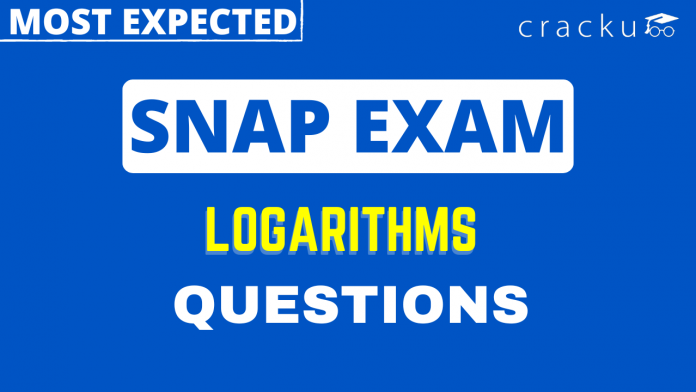SNAP Logarithms Questions PDF
Logarithms is an important topic in the Quant section of the SNAP Exam. You can also download this Free Logarithms Questions for SNAP PDF (with answers) by Cracku. These questions will help you to practice and solve the Logarithms questions in the SNAP exam. Utilize this PDF practice set, which is one of the best sources for practising.
Download Logarithms Questions for SNAP
Enroll to SNAP 2022 Crash Course
Question 1: Find the value of following expression $\log\sin 40^\circ \log \sin 41^\circ — \log \sin 99^\circ \log \sin 100^\circ$
a) $\frac{\sqrt{3ac}+1}{2}$
b) $0$
c) $1$
d) $2$
1) Answer (B)
Solution:
= $\log\sin 40^\circ \log \sin 41^\circ….. \log \sin 90^\circ…… \log \sin 99^\circ \log \sin 100^\circ$
= $\log \sin 90^\circ$
= log 1
= 0
Answer is option B.
Question 2: The value of $\log_2 x$ which satisfy $6 – 9\log_{8}\left(\frac{4}{x}\right)^{\frac{1}{3}} – 8(\log_{256}x)^{\frac{2}{3}} – (\log_2 x^8)^{\frac{1}{3}} = 0$ is
a) 2
b) $\sqrt{2}$
c) 4
d) 8
2) Answer (D)
Solution:
$6-9\log_8\left(\frac{4}{x}\right)^{\frac{1}{3}}-8\left(\log_{256}x\right)^{\frac{2}{3}}-\left(\log_{2\ }x^8\right)^{\frac{1}{3}}=0$
$6-\log_24+\log_2\ x-2\left(\log_2x\right)^{\frac{2}{3}}-2\left(\log_2x\right)^{\frac{1}{3}}=0$
Let $\left(\log_2x\right)^{\frac{1}{3}}$ be t.
$4+t^3-2t^2-2t=0$
or, $\left(t-2\right)\left(t^2-2\right)=0$
so, $t=2$ or
$\log_2\ x=8$
Question 3: For a real number a, if $\frac{\log_{15}{a}+\log_{32}{a}}{(\log_{15}{a})(\log_{32}{a})}=4$ then a must lie in the range
a) $2<a<3$
b) $3<a<4$
c) $4<a<5$
d) $a>5$
3) Answer (C)
Solution:
We have :$\frac{\log_{15}{a}+\log_{32}{a}}{(\log_{15}{a})(\log_{32}{a})}=4$
We get $\frac{\left(\frac{\log a}{\log\ 15}+\frac{\log a}{\log32}\right)}{\frac{\log a}{\log\ 15}\times\ \frac{\log a}{\log32}\ \ }=4$
we get $\log a\left(\log32\ +\log\ 15\right)=4\left(\log\ a\right)^2$
we get $\left(\log32\ +\log\ 15\right)=4\log a$
=$\log480=\log a^4$
=$a^4\ =480$
so we can say a is between 4 and 5 .
Question 4: If $\log_{2}[3+\log_{3} \left\{4+\log_{4}(x-1) \right\}]-2=0$ then 4x equals
4) Answer: 5
Solution:
We have :
$\log_2\left\{3+\log_3\left\{4+\log_4\left(x-1\right)\right\}\right\}=2$
we get $3+\log_3\left\{4+\log_4\left(x-1\right)\right\}=4$
we get $\log_3\left(4+\log_4\left(x-1\right)\ =\ 1\right)$
we get $4+\log_4\left(x-1\right)\ =\ 3$
$\log_4\left(x-1\right)\ =\ -1$
x-1 = 4^-1
x = $\frac{1}{4}+1=\frac{5}{4}$
4x = 5
Question 5: If $5 – \log_{10}\sqrt{1 + x} + 4 \log_{10} \sqrt{1 – x} = \log_{10} \frac{1}{\sqrt{1 – x^2}}$, then 100x equals
5) Answer: 99
Solution:
$5 – \log_{10}\sqrt{1 + x} + 4 \log_{10} \sqrt{1 – x} = \log_{10} \frac{1}{\sqrt{1 – x^2}}$
We can re-write the equation as: $5-\log_{10}\sqrt{1+x}+4\log_{10}\sqrt{1-x}=\log_{10}\left(\sqrt{1+x}\times\ \sqrt{1-x}\right)^{-1}$
$5-\log_{10}\sqrt{1+x}+4\log_{10}\sqrt{1-x}=\left(-1\right)\log_{10}\left(\sqrt{1+x}\right)+\left(-1\right)\log_{10}\left(\sqrt{1-x}\right)$
$5=-\log_{10}\sqrt{1+x}+\log_{10}\sqrt{1+x}-\log_{10}\sqrt{1-x}-4\log_{10}\sqrt{1-x}$
$5=-5\log_{10}\sqrt{1-x}$
$\sqrt{1-x}=\frac{1}{10}$
Squaring both sides: $\left(\sqrt{1-x}\right)^2=\frac{1}{100}$
$\therefore\ $ $x=1-\frac{1}{100}=\frac{99}{100}$
Hence, $100\ x\ =100\times\ \frac{99}{100}=99$
Enroll to SNAP & NMAT 2022 Crash Course
Question 6: If $\log \left(\frac{a}{b}\right) + \log \left(\frac{b}{a}\right) = \log(a + b)$, then which of the following statements is CORRECT?
a) a – b = 1
b) a + b = 1
c) a = b
d) $a^2 – b^2 = 1$
6) Answer (B)
Solution:
log(a/b) + log(b/a) = log(a+b)
log(a+b) = log(a/b)(b/a)
log(a+b)=log 1
a+b=1
Question 7: If $\log_4m + \log_4n = \log_2(m + n)$ where m and n are positive real numbers, then which of the following must be true?
a) $\frac{1}{m} + \frac{1}{n} = 1$
b) m = n
c) $m^2 + n^2 = 1$
d) $\frac{1}{m} + \frac{1}{n} = 2$
e) No values of m and n can satisfy the given equation
7) Answer (E)
Solution:
$\log_4mn=\log_2(m+n)$
$\sqrt{\ mn}=(m+n)$
Squarring on both sides
$m^2+n^2+mn\ =\ 0$
Since m, n are positive real numbers, no value of m and n satisfy the above equations.
Question 8: The value of $\log_{a}({\frac{a}{b}})+\log_{b}({\frac{b}{a}})$, for $1<a\leq b$ cannot be equal to
a) 0
b) -1
c) 1
d) -0.5
8) Answer (C)
Solution:
On expanding the expression we get $1-\log_ab+1-\log_ba$
$or\ 2-\left(\log_ab+\frac{1}{\log_ba}\right)$
Now applying the property of AM>=GM, we get that $\frac{\left(\log_ab+\frac{1}{\log_ba}\right)}{2}\ge1\ or\ \left(\log_ab+\frac{1}{\log_ba}\right)\ge2$ Hence from here we can conclude that the expression will always be equal to 0 or less than 0. Hence any positive value is not possible. So 1 is not possible.
Question 9: $\frac{2\times4\times8\times16}{(\log_{2}{4})^{2}(\log_{4}{8})^{3}(\log_{8}{16})^{4}}$ equals
9) Answer: 24
Solution:
$\frac{\left(2\cdot4\cdot8\cdot16\right)}{\left(\log_22^2\right)^2\cdot\left(\log_{2^2}2^3\right)^3\cdot\left(\log_{2^3}2^4\right)^4}\cdot$
= $\frac{2^{10}}{4\cdot\left(\frac{3}{2}\right)^3\cdot\left(\frac{4}{3}\right)^4}=24$
Question 10: If $\log_{a}{30}=A,\log_{a}({\frac{5}{3}})=-B$ and $\log_2{a}=\frac{1}{3}$, then $\log_3{a}$ equals
a) $\frac{2}{A+B-3}$
b) $\frac{2}{A+B}-3$
c) $\frac{A+B}{2}-3$
d) $\frac{A+B-3}{2}$
10) Answer (A)
Solution:
$\log_a30=A\ or\ \log_a5+\log_a2+\log_a3=A$………..(1)
$\log_a\left(\frac{5}{3}\right)=-B\ or\ \log_a3-\log_a5=B$………….(2)
and finally $\log_a2=3$
Substituting this in (1) we get $\log_a5+\log_a3=A-3$
Now we have two equations in two variables (1) and (2) . On solving we get
$\log_a3=\frac{\left(A+B-3\right)}{2\ }or\ \log_3a=\frac{2}{A+B-3}$
Take SNAP mock tests here
Enrol to 10 SNAP Latest Mocks For Just Rs. 499
Question 11: If $\log_{4}{5}=(\log_{4}{y})(\log_{6}{\sqrt{5}})$, then y equals
11) Answer: 36
Solution:
$\frac{\log\ 5}{2\log2}\ =\frac{\log\ y}{2\log2}\cdot\frac{\log\ 5}{2\log6}$
$\log\ 36\ =\ \log\ y;\ \therefore\ y\ =36$
Question 12: If Y is a negative number such that $2^{Y^2({\log_{3}{5})}}=5^{\log_{2}{3}}$, then Y equals to:
a) $\log_{2}(\frac{1}{5})$
b) $\log_{2}(\frac{1}{3})$
c) $-\log_{2}(\frac{1}{5})$
d) $-\log_{2}(\frac{1}{3})$
12) Answer (B)
Solution:
$2^{Y^2({\log_{3}{5})}}=5^{Y^2(\log_3 2)}$
Given, $5^{Y^2\left(\log_32\right)}=5^{\left(\log_23\right)}$
=> $Y^2\left(\log_32\right)=\left(\log_23\right)=>Y^2=\left(\log_23\right)^2$
=>$Y=\left(-\log_23\right)^{\ }or\ \left(\log_23\right)$
since Y is a negative number, Y=$\left(-\log_23\right)=\left(\log_2\frac{1}{3}\right)$
Question 13: Let x and y be positive real numbers such that
$\log_{5}{(x + y)} + \log_{5}{(x – y)} = 3,$ and $\log_{2}{y} – \log_{2}{x} = 1 – \log_{2}{3}$. Then $xy$ equals
a) 150
b) 25
c) 100
d) 250
13) Answer (A)
Solution:
We have, $\log_{5}{(x + y)} + \log_{5}{(x – y)} = 3$
=> $x^2-y^2=125$……(1)
$\log_{2}{y} – \log_{2}{x} = 1 – \log_{2}{3}$
=>$\ \frac{\ y}{x}$ = $\ \frac{\ 2}{3}$
=> 2x=3y => x=$\ \frac{\ 3y}{2}$
On substituting the value of x in 1, we get
$\ \frac{\ 5x^2}{4}$=125
=>y=10, x=15
Hence xy=150
Question 14: Sham is trying to solve the expression:
$\log \tan 1^\circ + \log \tan 2^\circ + \log \tan 3^\circ + …….. + \log \tan 89^\circ$.
The correct answer would be?
a) 1
b) $\frac{1}{\sqrt{2}}$
c) 0
d) -1
14) Answer (C)
Solution:
$\log \tan 1^\circ + \log \tan 2^\circ + \log \tan 3^\circ + …….. + \log \tan 89^\circ$.
=$\log \tan 1^\circ + \log \tan 89^\circ + \log \tan 2^\circ + \log \tan 88^\circ …….. + \log \tan 45^\circ$.
=$\log\ \left(\tan\ 1^0\cdot\tan\ 89^0\right)\times\log\ \left(\tan\ 2^0\cdot\tan\ 88^0\right)\ ………………………\log\ \left(\tan\ 45^0\right)$
tan $45^0$ = 1
$\log\ \left(\tan\ 45^0\right)\ =\ 0$
$\therefore$ $\log \tan 1^\circ + \log \tan 2^\circ + \log \tan 3^\circ + …….. + \log \tan 89^\circ$ = 0
Question 15: If $\log_{10}{11} = a$ then $\log_{10}{\left(\frac{1}{110}\right)}$ is equal to
a) $-a$
b) $(1 + a)^{-1}$
c) $\frac{1}{10 a}$
d) $-(a + 1)$
15) Answer (D)
Solution:
$\log_{10}{\left(\frac{1}{110}\right)}$
$\log_a\left(\ \frac{\ x}{y}\right)\ =\ \log_ax-\log_ay$
$\log_{10}{\left(\frac{1}{110}\right)}$ = $=\ \log_{10}1-\log_{10}110$
= 0$-\log_{10}110$
=$-\log_{10}11\times\ 10$
=$-\left(\log_{10}11+\log_{10}10\right)$
= -(a+1)
D is the correct answer.
Question 16: Find the value of $\log_{10}{10} + \log_{10}{10^2} + ….. + \log_{10}{10^n}$
a) $n^{2} + 1$
b) $n^{2} – 1$
c) $\frac{(n^{2} + n)}{2}.\frac{n(n + 1)}{3}$
d) $\frac{(n^{2} + n)}{2}$
16) Answer (D)
Solution:
$\log_{10}{10} + \log_{10}{10^2} + ….. + \log_{10}{10^n}$
Since $\log_aa\ $ = 1
$\log_{10}{10} + \log_{10}{10^2} + ….. + \log_{10}{10^n}$ = 1+2+….n
=$\ \frac{\ n\left(n+1\right)}{2}$
=$\frac{(n^{2} + n)}{2}$
D is the correct answer.
Question 17: what is the value of $\frac{\log_{27}{9} \times \log_{16}{64}}{\log_{4}{\sqrt2}}$?
a) $\frac{1}{6}$
b) $\frac{1}{4}$
c) 8
d) 4
17) Answer (D)
Solution:
$\frac{\log_{27}{9} \times \log_{16}{64}}{\log_{4}{\sqrt2}}$?
=$\frac{\ \log_{3^3}3^2\times\ \log_{2^4}2^6}{\log_{\left(\sqrt{\ 2}\right)^4}\sqrt{\ 2}}$
=$\frac{\ \ \frac{\ 2}{3}\times\ \frac{\ 6}{4}}{\ \frac{\ 1}{4}}$
=4
D is the correct answer.
Question 18: What is the value of x in the following expression?
$x + \log_{10} (1 + 2^x) = x \log_{10} 5 + \log_{10} 6$
a) 1
b) 0
c) -1
d) 3
18) Answer (A)
Solution:
The given equation can be written as
$\log\left(10\right)^{x\ }\ +\ \log\left(1+2^x\right)=\log\left(5\right)^x+\log6$
$\log\left(10\right)^{x\ }\left(1+2^x\right)=\log\left(5\right)^x\cdot6$ ( since logA + logB=logAB)
$\log\ \frac{\left(2^x\cdot5^x\right)\left(1+2^x\right)}{5^x\cdot6}=0$ ( since logA – logB=logA/B)
$\frac{\left(2^x\ +2^{2x\ }\right)}{6}=10^0$ ($Since\ \log_aN\ =x\ \ =>N=a^x$)
$2^{^x}+2^{2x}=6$
The above equation is satisfied only when x=1
Question 19: Find the value of $\log_{3^2}{5^4} \times \log_{5^2}{3^4}$
a) 5
b) 3
c) 4
d) 2
19) Answer (C)
Solution:
$\log_{b^n}\left(a^m\right)\ =\frac{m}{n}\log_ba\ =\frac{m}{n}\cdot\frac{\log\left(a\right)}{\log\left(b\right)}$
So given equation becomes $\frac{4}{2}\cdot\frac{4}{2}\cdot\frac{\log\left(3\right)}{\log\left(2\right)}\cdot\frac{\log\left(2\right)}{\log\left(3\right)}$ = 4
Question 20: $\log_{5}{25} + \log_{2} (\log_{3}{81})$ is
a) 1
b) 2
c) 3
d) 4
20) Answer (D)
Solution:
$\log\left(a^m\right)\ =\ m\log\left(a\right)\ and\ \ \log_aa$ = 1
$\log_55^2\ +\ \log_2\left(\log_33^4\right)$
2 + $\ \log_24$
2+ $\ \log_22^2$
4





